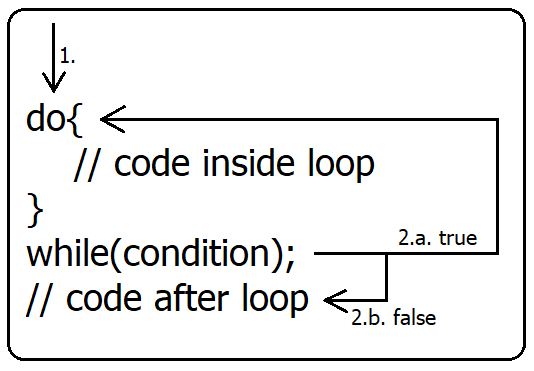Introduction to the while Statement in C++
Flow Diagram:

Loops are essential in controlling the flow of a program in C++. Among various types of loops, the while statement in c programming is more often than not called upon to execute repetitive tasks. It’s suitable for cases where it’s impossible to know beforehand how many times you’ll be repeating a certain process. This kind of loop keeps on executing whatever is within its braces unless instructed otherwise through its conditions. Therefore, understanding how while statements in C++ are supposed to work and when they should be used is very important in programming with C++.
Basic Syntax of the while Loop
The syntax of the while loop is straightforward:
while (condition) {
// Code to be executed repeatedly
}Here’s a breakdown of the syntax:
- condition: The loop continues as long as this condition is true. Once it becomes false, the loop terminates.
- code block: The set of instructions inside the loop that are executed each time the condition is evaluated as true.
A basic example of a while loop looks like this:
int counter = 0;
while (counter < 5) {
std::cout << "Counter is: " << counter << std::endl;//
counter++;
}In this example, the loop runs five times, incrementing the value of counter each time until it reaches 5.while Statements in C++
Working of the while Statement in C++
This type of entry-control means that before entering the loop, a condition is checked in C++. If the condition is false from the outset, then there will never be any execution of the loop body. Because of this, it can come in handy when you are not sure about how many times you’re going to repeat certain operations because those times depend on changing circumstances. The following steps summarize this action:
1. Check for a condition
2. If condition holds true, execute instructions in braces
3. Re-evaluate the condition after completion
4. Perform all these steps until stated otherwise by an opposite logical statement.
Such movement guarantees that looping will only continue as per need making them great tools for managing unpredictable scenarios within your algorithms.
Key Features of the while Statement in C++
A major aspect of the while loop is checking conditions before executing the loop body. This feature makes it a pre-test loop. If the condition is false at first, the loop body will not be executed even once.
Another common occurrence with while loops is infinite looping which happens when the loop’s condition always holds true. For example:
while (true) {
// This loop runs infinitely
}This type of loop can be useful in specific cases, like waiting for user input, but it must be used with caution to avoid unintentional infinite execution.
Use Cases for the while Statement in C++
The while loop is versatile and finds application in a variety of situations:
- Input validation: Making sure that user inputs are correct; for instance asking repeatedly for correct number or choice.
- Menu driven programs: Carrying on a menu that permits users to select an option until they terminate it.
- Simulations and games: Implementing situations where actions are repeated until a different certain state changes; like playing a game until one loses it.
Common Mistakes When Using while Loops
Mistakes when using while loops
While while loops are fast such accidents can happen
- Infinite loops: We previously said this exists if the loop’s condition is always true. This may cause your program to hang forever or shut down without warning.
- Off-by-one errors: Here, the loop runs either too many times or too few hence incorrect increments and decrements among others often result in confusion.
- Mismanagement of loop control variables: Forgetting to update the control variable within the loop can lead to unexpected behavior or infinite loops.
The Importance of Loop Control in while Loops
The correct execution of a while loop can effectively be ensured by properly managing control variables. In most cases, these variables determine when to stop the loop. The functionalities of loops can be greatly enhanced through proper use of control statements such as break (to prematurely exit from the loop) and continue statement (to skip to next iteration). Complex scenarios like matrix operations may also require nested while loops which are those that one operates inside another.
Nested while Loops in C++
Nested while loops involve placing one while loop inside another, allowing for multi-level iterations. An example of this is:
int i = 0, j;
while (i < 3) {
j = 0;
while (j < 3) {
std::cout << i << " " << j << std::endl;
j++;
}
i++;
}This code produces a grid of coordinates, demonstrating how nested loops work together.
Input Validation Using a while Loop
One practical use of a while loop is input validation. Here, the loop repeatedly asks for valid input until the user provides it:
int number;
std::cout << "Enter a positive number: ";
std::cin >> number;
while (number <= 0) {
std::cout << "Invalid input. Please enter a positive number: ";
std::cin >> number;
}This approach ensures the program only accepts appropriate data, making it more robust.
Difference Between while and do-while Loops
The while loop checks the condition before executing the loop body, whereas the do-while loop checks the condition after executing the loop body at least once:
do {
// Code to be executed
} while (condition);This makes
do-while suitable when the loop must run at least once, regardless of the initial condition.
Infinite Loops: Causes and Solutions
Infinite loops can cause significant issues, including program crashes and unresponsiveness. They usually occur when the loop’s condition never becomes false, such as:
while (x != 10) {
// Forgetting to update x
}To prevent this, ensure the loop control variable is updated correctly, and use debugging tools to trace issues in complex loops.
Performance Considerations in while Loops
Loosely speaking performance issues may arise when working with loops especially in large scale programs. Therefore Complex loop conditions, excessive nesting, or heavy computations within would definitely slow down your program. Therefore Optimizing conditions and reducing unnecessary calculations help in performance improvement.
Advanced while Loop Techniques
You can enhance while loops with more advanced techniques, such as:
- Using complex logical conditions.
- Combining loops with functions for modular code.
- Implementing time-based loops for real-time applications.
These techniques are useful for writing more adept and flexible C++ programs.
Practical Examples of while Loops in C++ Programming
Here are some common algorithms implemented using while loops:
- Number guessing game: A loop that keeps asking user to guess number until they guess right.
- Simple calculator: By using a loop, create a menu driven calculator which allows users to do multiple operations until they want to quit.
Conclusion
For controlling program flow, particularly when the number of iterations isn’t known beforehand, the C++ while loop is quite flexible. With its syntax under one’s belt, nuances understood and applicable contexts recognized, it becomes possible for someone to exploit the while loop in constructing effective and adaptable applications.





